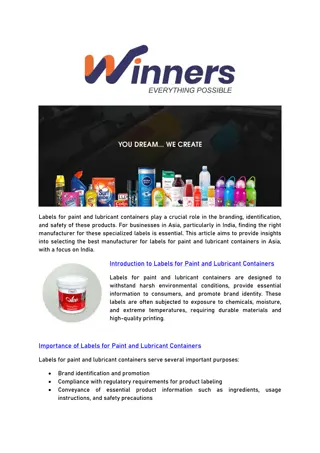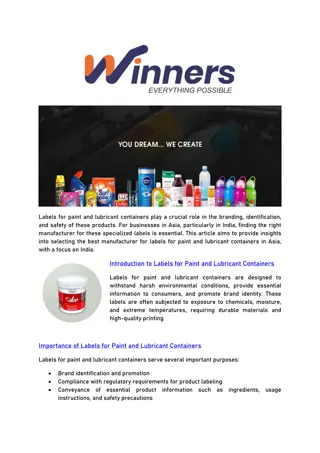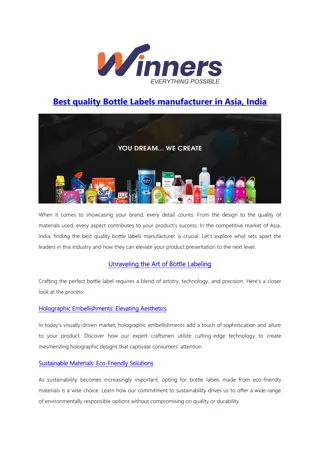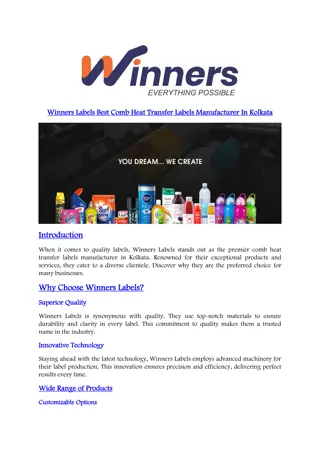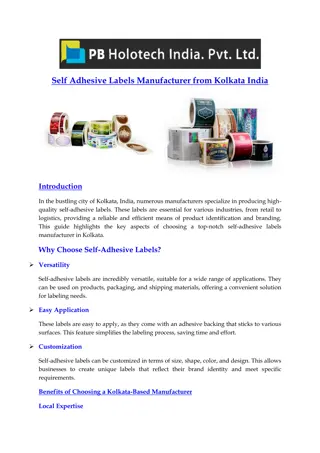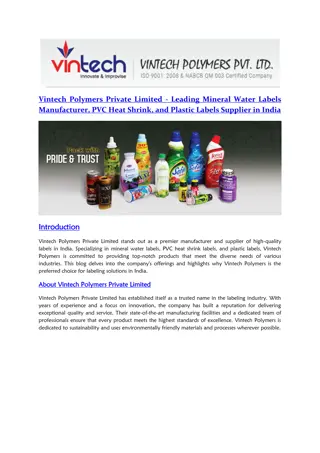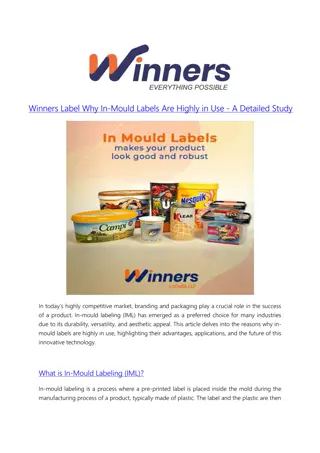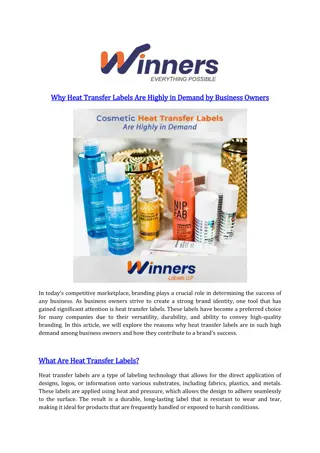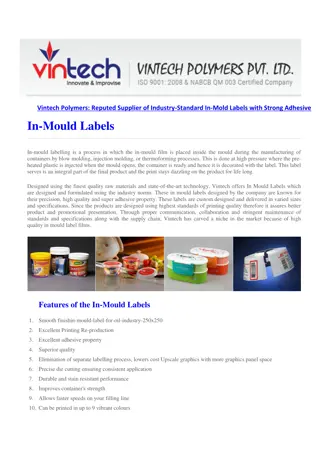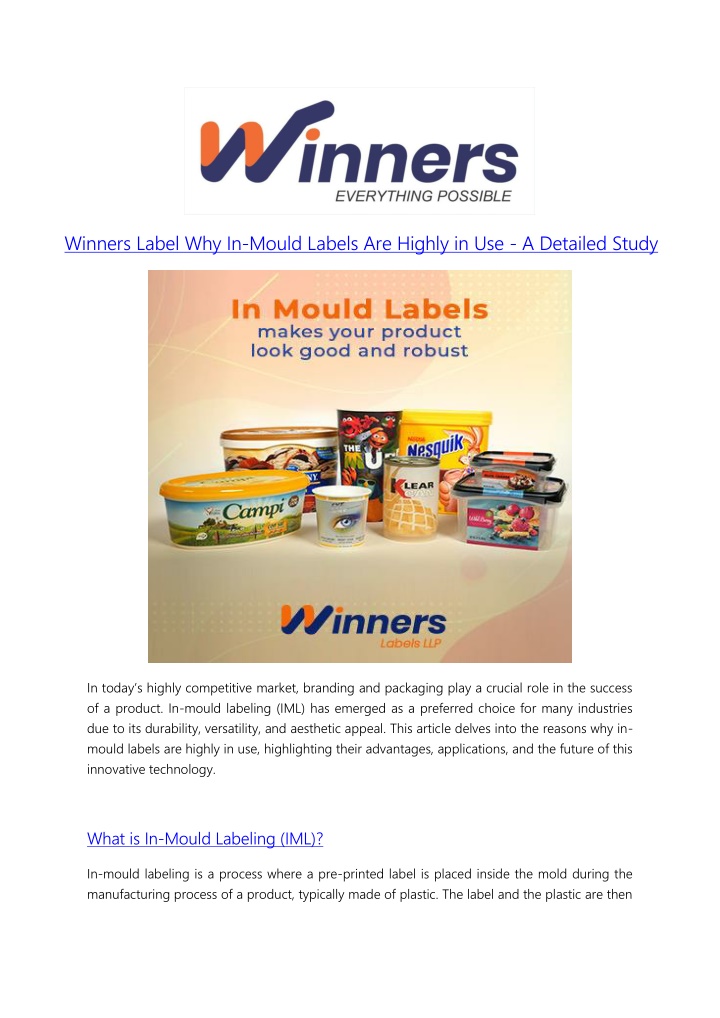
Winners Label Why In-Mould Labels Are Highly in Use - A Detailed Study
In-mould labels are nothing but printed polypropylene labels and it takes the shape of a container post that is directly injected in the mould. The overall process results in making the mould & labels get united together. There are three key process
Uploaded on | 1 Views
Download Presentation

Please find below an Image/Link to download the presentation.
The content on the website is provided AS IS for your information and personal use only. It may not be sold, licensed, or shared on other websites without obtaining consent from the author. If you encounter any issues during the download, it is possible that the publisher has removed the file from their server.
You are allowed to download the files provided on this website for personal or commercial use, subject to the condition that they are used lawfully. All files are the property of their respective owners.
The content on the website is provided AS IS for your information and personal use only. It may not be sold, licensed, or shared on other websites without obtaining consent from the author.
E N D
Presentation Transcript
Winners Label Why In-Mould Labels Are Highly in Use - A Detailed Study In today s highly competitive market, branding and packaging play a crucial role in the success of a product. In-mould labeling (IML) has emerged as a preferred choice for many industries due to its durability, versatility, and aesthetic appeal. This article delves into the reasons why in- mould labels are highly in use, highlighting their advantages, applications, and the future of this innovative technology. What is In-Mould Labeling (IML)? In-mould labeling is a process where a pre-printed label is placed inside the mold during the manufacturing process of a product, typically made of plastic. The label and the plastic are then
molded together, creating a single, seamless entity. This technology is widely used in the packaging industry for products such as containers, bottles, and other plastic items. The Evolution of In-Mould Labeling IML technology has evolved significantly over the years, from simple paper labels to highly sophisticated, durable labels that can withstand harsh environments. The demand for in-mould labeling has increased as industries seek to improve the visual appeal and functionality of their packaging while also reducing costs and environmental impact. Key Benefits of In-Mould Labels The growing popularity of in-mould labels can be attributed to several key benefits that make them an attractive option for manufacturers and brands alike. Here are some of the most significant advantages: Durability and Resistance One of the primary reasons for the widespread use of in-mould labels is their exceptional durability. Since the label becomes an integral part of the product during the molding process, it is highly resistant to scratches, water, and chemicals. This makes IML an ideal choice for products that will be exposed to harsh conditions, such as cleaning agents or outdoor environments. High-Quality Aesthetics In-mould labels offer superior aesthetic quality compared to traditional labeling methods. The label is printed with high-resolution images and vibrant colors, resulting in a visually appealing product. Additionally, IML provides a seamless finish with no visible edges or bubbles, enhancing the overall look and feel of the product. Cost Efficiency While the initial setup costs for in-mould labeling may be higher than other methods, it can lead to significant cost savings in the long run. IML eliminates the need for secondary labeling processes, reducing labor and material costs. Moreover, the durability of in-mould labels reduces the likelihood of damage or re-labeling, further lowering expenses.
Eco-Friendly Option In-mould labeling is considered a more eco-friendly option compared to traditional labeling methods. Since the label and the product are made from the same material, the entire item can be recycled without the need to separate the label from the container. This reduces waste and supports sustainable packaging initiatives. Improved Brand Recognition IML allows for greater branding opportunities by offering more design flexibility. Brands can use high-quality graphics and innovative designs to create a strong visual identity, making their products stand out on the shelves. The seamless integration of the label with the product also ensures that the brand's message remains clear and intact throughout the product's lifecycle. Applications of In-Mould Labels In-mould labeling is used across various industries, each benefiting from its unique advantages. Here are some of the key applications of IML: Food and Beverage Industry The food and beverage industry is one of the largest users of in-mould labeling. IML is commonly used for packaging products such as yogurt containers, ice cream tubs, and beverage bottles. The durability and resistance of IML make it ideal for food packaging, ensuring that labels remain intact even in cold storage or during transportation. Personal Care Products In the personal care industry, in-mould labels are used for products like shampoo bottles, lotion containers, and cosmetic packaging. The high-quality aesthetics of IML help brands convey a premium image, while the labels resistance to moisture and chemicals ensures they remain in pristine condition. Household and Industrial Products IML is also widely used in the packaging of household and industrial products. Items such as cleaning agents, automotive fluids, and garden supplies benefit from the
durability and resistance of in-mould labels. The ability to withstand harsh environments makes IML the preferred choice for these types of products. Toys and Promotional Items The toy industry often utilizes in-mould labeling for its products due to the durability and safety of the labels. Since IML is integrated into the product, there is no risk of small labels peeling off, which could pose a choking hazard. Additionally, the high- quality graphics offered by IML make toys more attractive to consumers. The Future of In-Mould Labeling The future of in-mould labeling looks promising as the demand for sustainable and high-quality packaging continues to grow. Advances in technology are expected to further enhance the capabilities of IML, offering even more design possibilities and improving efficiency. Here are some trends to watch in the coming years: Sustainable Materials As the push for sustainability intensifies, there will be a greater focus on using sustainable materials for in-mould labels. This includes the development of biodegradable and compostable materials that can be integrated with IML technology, further reducing the environmental impact of packaging. Smart Labels The integration of smart technology with in-mould labels is another exciting trend. This could include labels with embedded QR codes, NFC chips, or sensors that provide additional information to consumers, such as product authenticity, usage instructions, or promotional offers.
Enhanced Printing Techniques Advances in printing technology will allow for even more detailed and vibrant designs on in-mould labels. This will enable brands to create more eye-catching packaging that captures consumer attention and enhances brand recognition. Customization and Personalization The ability to customize and personalize packaging is becoming increasingly important in today s market. In-mould labeling is well-suited to meet this demand, with the capability to produce small runs of customized labels that cater to specific markets or promotional campaigns. Challenges in In-Mould Labeling While in-mould labeling offers numerous benefits, there are also challenges that manufacturers need to consider: Initial Setup Costs The initial setup costs for in-mould labeling can be higher than other labeling methods, particularly for small or medium-sized businesses. The cost of molds, printing equipment, and specialized machinery can be a significant investment. Complex Production Process IML involves a more complex production process compared to traditional labeling. This requires specialized knowledge and skills, as well as precise coordination between label production and the molding process. Ensuring consistent quality can be challenging, particularly in high-volume production. Material Compatibility Ensuring material compatibility between the label and the product is crucial for successful in- mould labeling. The label material must bond effectively with the plastic during the molding process, which can be challenging with certain types of plastics or label materials.
Conclusion In-mould labeling has revolutionized the packaging industry by offering a durable, aesthetically pleasing, and cost-effective solution for product branding. Its growing popularity can be attributed to the numerous benefits it offers, including improved durability, high-quality aesthetics, cost efficiency, and environmental sustainability. As technology continues to advance, the future of in-mould labeling looks bright, with new innovations set to enhance its capabilities and expand its applications. Despite the challenges, the advantages of IML make it a highly attractive option for manufacturers looking to create standout packaging that meets the demands of today s market. Tags:in mould labels, in mold labeling injection molding, in mold labeling process, in mould label printing, iml in mold labelling, in mould labelling companies, iml in mould labelling, in mould printing GET IN TOUCH WITH US: Winners Labels CB - 70, SALT LAKE CITY, KOLKATA - 700 064 CONTACT NO: +91 9830087119 / 9831070140 / 9831016222 EMAIL: INFO@WINNERSLABELS.COM WEBSITE: https://www.winnerslabels.com/





